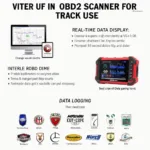The OBD2 16 pin male connector is the backbone of vehicle diagnostics, providing a standardized interface for accessing a vehicle’s onboard computer. Understanding its pinout, functionality, and common issues is crucial for anyone working with vehicle diagnostics. This article dives deep into the world of the obd2 16 pin male connector, providing valuable insights for both professionals and car enthusiasts.
Decoding the OBD2 16 Pin Male Connector Pinout
The OBD2 standard, implemented in most vehicles since 1996 in the US, uses a 16-pin male connector. Each pin has a specific function, enabling communication between the diagnostic tool and the vehicle’s various control modules. While some pins are standardized across all manufacturers, others are manufacturer-specific, allowing for proprietary diagnostics. Knowing the standard pinout is crucial for troubleshooting connectivity problems. For example, pin 4 (chassis ground) and pin 16 (battery power) are essential for powering the OBD2 scanner. Pin 2 and pin 10 are vital for communication.
You can find more information on the female counterpart at obd2 16 pin female connector.
Common Issues with the OBD2 16 Pin Male Connector
Several issues can arise with the obd2 16 pin male connector, often leading to frustrating diagnostic experiences. Bent or corroded pins are a frequent culprit, preventing proper contact with the scanner. Loose connections can also cause intermittent communication issues. Furthermore, damaged wiring within the connector or the vehicle’s wiring harness can interrupt communication entirely. Understanding these common problems empowers users to troubleshoot effectively and ensures accurate diagnostic readings. Having trouble locating your port? Our guide on where is my obd2 port can be extremely helpful.
Utilizing the OBD2 16 Pin Male Connector for Diagnostics
The obd2 16 pin male connector allows access to a wealth of vehicle data, enabling mechanics and car enthusiasts to diagnose issues, monitor performance, and customize vehicle settings. From reading and clearing diagnostic trouble codes (DTCs) to monitoring live data streams and performing emissions tests, this connector is a gateway to the inner workings of your vehicle. Specific functionalities like checking engine coolant temperature, fuel pressure, and even transmission fluid levels are all accessible through this crucial interface. Check out our resources on specific vehicle models, like the 2006 subaru tribeca obd2 connector location and the impreza 2016 obd2 connector.
What are the benefits of using an OBD2 scanner?
An OBD2 scanner allows you to diagnose car problems, monitor performance, and even customize some vehicle settings.
How do I choose the right OBD2 scanner?
Consider your needs and budget. Basic scanners are suitable for reading and clearing codes, while advanced scanners offer more features like live data streaming.
 OBD2 Scanner Connected to 16-Pin Connector
OBD2 Scanner Connected to 16-Pin Connector
Conclusion
The obd2 16 pin male connector is an integral component of modern vehicle diagnostics. Understanding its pinout, common issues, and diagnostic capabilities is paramount for anyone involved in vehicle maintenance and repair. From simple code reading to advanced data analysis, this connector empowers users with the knowledge and tools necessary to keep their vehicles running smoothly. Regularly inspecting and maintaining the obd2 16 pin male connector ensures reliable and accurate diagnostic readings. Need help with a specific model like the obd2 port honda civicc 2000? We’ve got you covered.
FAQ
- What is the purpose of the obd2 16 pin male connector?
- It provides a standardized interface for connecting diagnostic tools to a vehicle’s onboard computer.
- What are the most common problems with the connector?
- Bent pins, corroded pins, and loose connections are common issues.
- How can I troubleshoot connectivity problems?
- Check for physical damage, ensure proper connection, and verify power and ground.
- What information can I access through the obd2 16 pin male connector?
- You can access DTCs, live data streams, and perform emissions tests.
- Where can I find more information about the pinout?
- Refer to your vehicle’s service manual or online resources.
- How often should I check the connector?
- Periodically inspect the connector for damage and ensure a secure connection.
- What should I do if I suspect a faulty connector?
- Consult a qualified mechanic for diagnosis and repair.
Need expert assistance? Reach out to us via WhatsApp: +1(641)206-8880, Email: [email protected] or visit our office at 789 Elm Street, San Francisco, CA 94102, USA. Our 24/7 customer support team is always ready to help.
